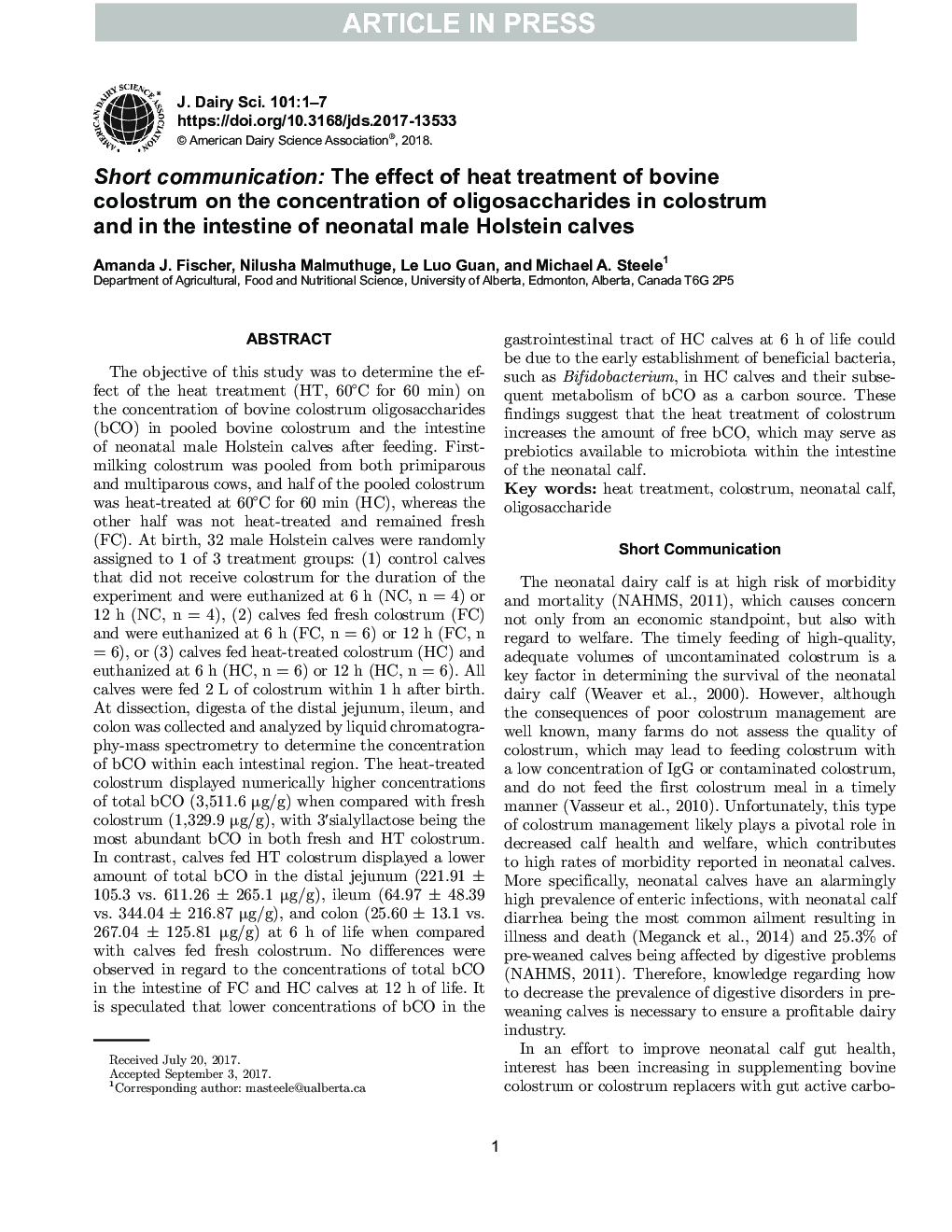| کد مقاله | کد نشریه | سال انتشار | مقاله انگلیسی | نسخه تمام متن |
|---|---|---|---|---|
| 8501660 | 1553844 | 2018 | 7 صفحه PDF | دانلود رایگان |
عنوان انگلیسی مقاله ISI
Short communication: The effect of heat treatment of bovine colostrum on the concentration of oligosaccharides in colostrum and in the intestine of neonatal male Holstein calves
ترجمه فارسی عنوان
ارتباط کوتاه: اثر درمان حرارتی گلولاشت گاو در غلظت الیگوساکارید ها در کلستروم و در روده گوساله های هولشتاین مرد نر
دانلود مقاله + سفارش ترجمه
دانلود مقاله ISI انگلیسی
رایگان برای ایرانیان
کلمات کلیدی
حرارت درمانی، چای سبز گوساله نوزاد الیگوساکارید،
موضوعات مرتبط
علوم زیستی و بیوفناوری
علوم کشاورزی و بیولوژیک
علوم دامی و جانورشناسی
چکیده انگلیسی
The objective of this study was to determine the effect of the heat treatment (HT, 60°C for 60 min) on the concentration of bovine colostrum oligosaccharides (bCO) in pooled bovine colostrum and the intestine of neonatal male Holstein calves after feeding. First-milking colostrum was pooled from both primiparous and multiparous cows, and half of the pooled colostrum was heat-treated at 60°C for 60 min (HC), whereas the other half was not heat-treated and remained fresh (FC). At birth, 32 male Holstein calves were randomly assigned to 1 of 3 treatment groups: (1) control calves that did not receive colostrum for the duration of the experiment and were euthanized at 6 h (NC, n = 4) or 12 h (NC, n = 4), (2) calves fed fresh colostrum (FC) and were euthanized at 6 h (FC, n = 6) or 12 h (FC, n = 6), or (3) calves fed heat-treated colostrum (HC) and euthanized at 6 h (HC, n = 6) or 12 h (HC, n = 6). All calves were fed 2 L of colostrum within 1 h after birth. At dissection, digesta of the distal jejunum, ileum, and colon was collected and analyzed by liquid chromatography-mass spectrometry to determine the concentration of bCO within each intestinal region. The heat-treated colostrum displayed numerically higher concentrations of total bCO (3,511.6 μg/g) when compared with fresh colostrum (1,329.9 μg/g), with 3â²-sialyllactose being the most abundant bCO in both fresh and HT colostrum. In contrast, calves fed HT colostrum displayed a lower amount of total bCO in the distal jejunum (221.91 ± 105.3 vs. 611.26 ± 265.1 μg/g), ileum (64.97 ± 48.39 vs. 344.04 ± 216.87 μg/g), and colon (25.60 ± 13.1 vs. 267.04 ± 125.81 μg/g) at 6 h of life when compared with calves fed fresh colostrum. No differences were observed in regard to the concentrations of total bCO in the intestine of FC and HC calves at 12 h of life. It is speculated that lower concentrations of bCO in the gastrointestinal tract of HC calves at 6 h of life could be due to the early establishment of beneficial bacteria, such as Bifidobacterium, in HC calves and their subsequent metabolism of bCO as a carbon source. These findings suggest that the heat treatment of colostrum increases the amount of free bCO, which may serve as prebiotics available to microbiota within the intestine of the neonatal calf.
ناشر
Database: Elsevier - ScienceDirect (ساینس دایرکت)
Journal: Journal of Dairy Science - Volume 101, Issue 1, January 2018, Pages 401-407
Journal: Journal of Dairy Science - Volume 101, Issue 1, January 2018, Pages 401-407
نویسندگان
Amanda J. Fischer, Nilusha Malmuthuge, Le Luo Guan, Michael A. Steele,
